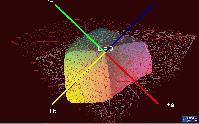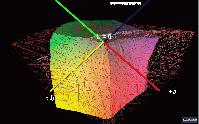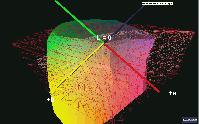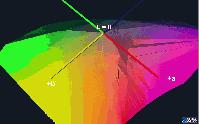- Joined
- Feb 24, 2005
- Messages
- 1,669
- Reaction score
- 183
- Points
- 223
- Location
- North of Boston, USA
- Printer Model
- Canon i9900 (plus 5 spares)
If you want compare the gamuts of color spaces/printers/cameras/etc., I suggest that you look at (http://www.drycreekphoto.com/tools/printer_gamuts/). Color gamuts are 3_D creatures, so you will need to download a VRML viewer to allow you to rotate them into different views to see the differences. Because many people wont want to do this, I have posted 4 comparisons. In every case, the gray wireframe is the sRGB color space, the red wireframe is the aRGB color space and the solid blob is the gamut of the stated device. I tried to rotate them to approximately the same viewing angle. These images were all captured from screenshots.
This is the type of photo printer used by Costco (and many others) to print low cost digital photos it uses a traditional Chemical Process to develop an image digitally exposed onto traditional photo paper (Fuji Crystal Archive in this case). You can see that the aRGB color space is larger than the sRGB color space, but that the Noritsus range of colors almost completely falls within the sRGB color space from this view. If you download the viewer and rotate this image, you will find that there are some colors that extend outside of even the aRGB color space.

This is the color gamut of a Canon i950 (OEM inks on Canon PPPro paper). This view makes it clear that even an "old" 950 can print many colors that fall outside of sRGB (and some that even fall outside of aRGB). This color gamut exceeds that of a "traditional photo" in almost every area.

This is the color gamut of a Canon i9900, which adds red and green inks to the i950s 6 inks. As would be expected, the two extra inks extend the gamut in some colors, but not in others.

This shows that digital cameras have the ability to capture colors that fall FAR outside of even aRGB. This camera is a Pro-body Canon IDs Mark II, but even lesser cameras can record values well outside of sRGB. For "snapshot quality" images, our brain does a great job of creating a good color range out of the reduced sRGB color set. However, if you are trying to capture a sunset over the Grand Canyon, sRGB just cant do justice to mother nature.

This is the type of photo printer used by Costco (and many others) to print low cost digital photos it uses a traditional Chemical Process to develop an image digitally exposed onto traditional photo paper (Fuji Crystal Archive in this case). You can see that the aRGB color space is larger than the sRGB color space, but that the Noritsus range of colors almost completely falls within the sRGB color space from this view. If you download the viewer and rotate this image, you will find that there are some colors that extend outside of even the aRGB color space.

This is the color gamut of a Canon i950 (OEM inks on Canon PPPro paper). This view makes it clear that even an "old" 950 can print many colors that fall outside of sRGB (and some that even fall outside of aRGB). This color gamut exceeds that of a "traditional photo" in almost every area.

This is the color gamut of a Canon i9900, which adds red and green inks to the i950s 6 inks. As would be expected, the two extra inks extend the gamut in some colors, but not in others.

This shows that digital cameras have the ability to capture colors that fall FAR outside of even aRGB. This camera is a Pro-body Canon IDs Mark II, but even lesser cameras can record values well outside of sRGB. For "snapshot quality" images, our brain does a great job of creating a good color range out of the reduced sRGB color set. However, if you are trying to capture a sunset over the Grand Canyon, sRGB just cant do justice to mother nature.

